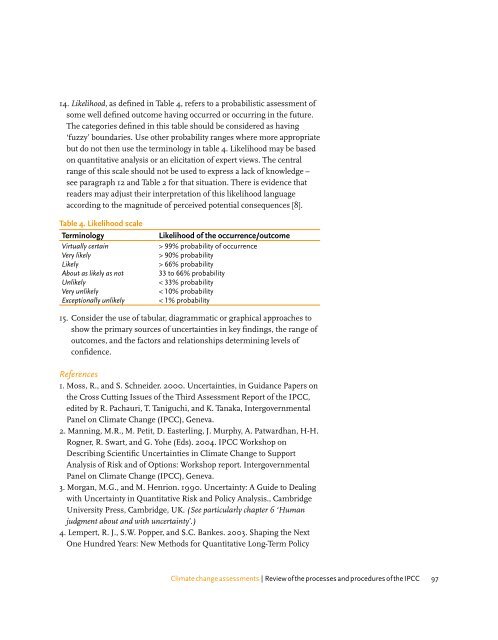Climate change assessments Review of the processes and ...
Climate change assessments Review of the processes and ...
Climate change assessments Review of the processes and ...
Create successful ePaper yourself
Turn your PDF publications into a flip-book with our unique Google optimized e-Paper software.
14. Likelihood, as defined in Table 4, refers to a probabilistic assessment <strong>of</strong><br />
some well defined outcome having occurred or occurring in <strong>the</strong> future.<br />
The categories defined in this table should be considered as having<br />
‘fuzzy’ boundaries. Use o<strong>the</strong>r probability ranges where more appropriate<br />
but do not <strong>the</strong>n use <strong>the</strong> terminology in table 4. Likelihood may be based<br />
on quantitative analysis or an elicitation <strong>of</strong> expert views. The central<br />
range <strong>of</strong> this scale should not be used to express a lack <strong>of</strong> knowledge –<br />
see paragraph 12 <strong>and</strong> Table 2 for that situation. There is evidence that<br />
readers may adjust <strong>the</strong>ir interpretation <strong>of</strong> this likelihood language<br />
according to <strong>the</strong> magnitude <strong>of</strong> perceived potential consequences [8].<br />
Table 4. Likelihood scale<br />
Terminology<br />
Virtually certain<br />
Very likely<br />
Likely<br />
About as likely as not<br />
Unlikely<br />
Very unlikely<br />
Exceptionally unlikely<br />
Likelihood <strong>of</strong> <strong>the</strong> occurrence/outcome<br />
> 99% probability <strong>of</strong> occurrence<br />
> 90% probability<br />
> 66% probability<br />
33 to 66% probability<br />
< 33% probability<br />
< 10% probability<br />
< 1% probability<br />
15. Consider <strong>the</strong> use <strong>of</strong> tabular, diagrammatic or graphical approaches to<br />
show <strong>the</strong> primary sources <strong>of</strong> uncertainties in key findings, <strong>the</strong> range <strong>of</strong><br />
outcomes, <strong>and</strong> <strong>the</strong> factors <strong>and</strong> relationships determining levels <strong>of</strong><br />
confidence.<br />
References<br />
1. Moss, R., <strong>and</strong> S. Schneider. 2000. Uncertainties, in Guidance Papers on<br />
<strong>the</strong> Cross Cutting Issues <strong>of</strong> <strong>the</strong> Third Assessment Report <strong>of</strong> <strong>the</strong> IPCC,<br />
edited by R. Pachauri, T. Taniguchi, <strong>and</strong> K. Tanaka, Intergovernmental<br />
Panel on <strong>Climate</strong> Change (IPCC), Geneva.<br />
2. Manning, M.R., M. Petit, D. Easterling, J. Murphy, A. Patwardhan, H-H.<br />
Rogner, R. Swart, <strong>and</strong> G. Yohe (Eds). 2004. IPCC Workshop on<br />
Describing Scientific Uncertainties in <strong>Climate</strong> Change to Support<br />
Analysis <strong>of</strong> Risk <strong>and</strong> <strong>of</strong> Options: Workshop report. Intergovernmental<br />
Panel on <strong>Climate</strong> Change (IPCC), Geneva.<br />
3. Morgan, M.G., <strong>and</strong> M. Henrion. 1990. Uncertainty: A Guide to Dealing<br />
with Uncertainty in Quantitative Risk <strong>and</strong> Policy Analysis., Cambridge<br />
University Press, Cambridge, UK. (See particularly chapter 6 ‘Human<br />
judgment about <strong>and</strong> with uncertainty’.)<br />
4. Lempert, R. J., S.W. Popper, <strong>and</strong> S.C. Bankes. 2003. Shaping <strong>the</strong> Next<br />
One Hundred Years: New Methods for Quantitative Long-Term Policy<br />
<strong>Climate</strong> <strong>change</strong> <strong>assessments</strong> | <strong>Review</strong> <strong>of</strong> <strong>the</strong> <strong>processes</strong> <strong>and</strong> procedures <strong>of</strong> <strong>the</strong> IPCC 97

















